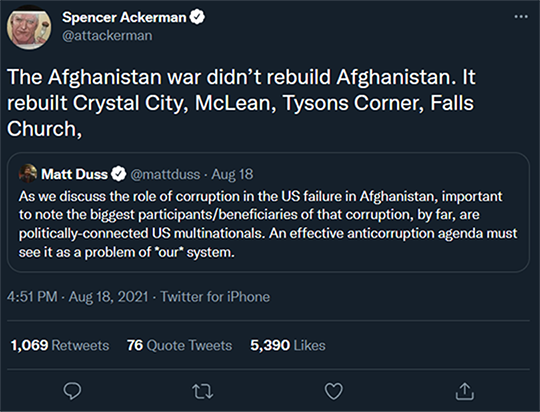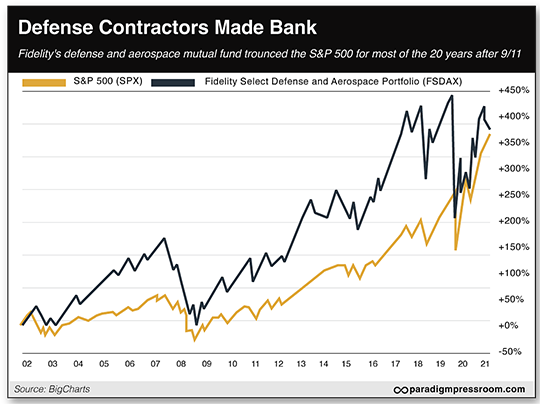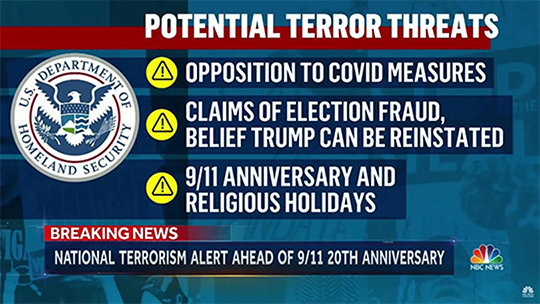“A Totalitarian Bureaucracy Within Our Shores”
- The most brilliant leveraged bet in history
- How conservatives came to love Big Government
- James Madison’s wisdom, Ronald Reagan’s delusion
- Ike’s startling cost-benefit analysis
- Russia, China, Iran: Always an enemy somewhere
![]() Bin Laden’s 16,086,000:1 Return
Bin Laden’s 16,086,000:1 Return
 Sept. 11, 2001 — the day Osama bin Laden pulled off the most brilliant leveraged bet in history.
Sept. 11, 2001 — the day Osama bin Laden pulled off the most brilliant leveraged bet in history.
We’re a couple of weeks past the 22nd anniversary of 9/11. The political class in this country posted a lot of maudlin “Never Forget” memes on their social media accounts.
Today we pause from our usual fare for a different kind of remembrance — examining the money-and-markets angle of the attacks, and lamenting the loss of liberties in the ensuing 22 years.
After all, the power elite couldn’t have pulled off COVID lockdowns, restrictions and mandates if they hadn’t first laid the groundwork with the Patriot Act and “See something, say something.”
We begin by recalling the words attributed to bin Laden in a speech from 2004: “We, alongside the mujahideen, bled Russia for 10 years until it went bankrupt and was forced to withdraw [from Afghanistan] in defeat… So we are continuing this policy in bleeding America to the point of bankruptcy.”
 Mission accomplished — for bin Laden. We’ve recounted the numbers before, but they’re worth a revisit.
Mission accomplished — for bin Laden. We’ve recounted the numbers before, but they’re worth a revisit.
The final report of the 9/11 Commission estimated al-Qaida spent about $500,000 to carry out its mission.
In September 2021, the Costs of War Project at Brown University issued a deeply researched estimate of the forever wars’ price tag to the U.S. government: $8.043 trillion, including veterans’ health care and interest on the wars’ share of the national debt.
So over 20 years, bin Laden generated a return of 16,086,000:1. Formidable.
 The return generated by the “defense” industry wasn’t quite as impressive… but it’s still eye-watering.
The return generated by the “defense” industry wasn’t quite as impressive… but it’s still eye-watering.
Per figures from the Center for Responsive Politics, the Big Five military contractors — Lockheed Martin, Boeing, Northrop Grumman, Raytheon (now branded RTX) and General Dynamics — spent over $1.1 billion on lobbying between 2001–21.
A substantial sum, yes, but look at the payoff: According to Stephen Semler, co-founder of the Security Policy Reform Institute, Congress awarded $2.02 trillion to those five companies over that 20-year span.
That’s a return of 1,836:1.

For most of that 20-year period, defense stocks outperformed the S&P 500 — and not by a little.

Only after it was apparent that U.S. involvement in Afghanistan was finally winding down in 2021 did the broad stock market close the gap with defense stocks.
And then the Ukraine war came to the rescue of the military-industrial complex less than a year later. But we’re getting ahead of ourselves…
![]() How Conservatives Came to Love Big Government
How Conservatives Came to Love Big Government
 Sept. 11, 2001, was also the day many conservatives abandoned their suspicions of Big Government.
Sept. 11, 2001, was also the day many conservatives abandoned their suspicions of Big Government.
Despite the epic intelligence failures in the weeks before the attacks, conservatives suddenly found a new faith in lumbering government bureaucracies. Indeed, they couldn’t wait to create more of them.
“At the time of the 9/11 attacks,” journalist James Bovard recalled in 2021 for the Mises Institute, “I had been bashing government policies for 20 years. Conservatives relished my battering of the Clinton administration in books such as Feeling Your Pain.”
But then Bovard cast an equally jaundiced eye toward the Bush administration in volumes like Terrorism and Tyranny and The Bush Betrayal. “The Patriot Act,” he wrote in the former volume, “treats every citizen like a suspected terrorist and every federal agent like a proven angel.”
Conservatives didn’t want to hear it. On one book tour after another, “I was chagrined to see folks more fearful of alleged invisible Muslim perils than of rampaging federal agencies.”
And so began an ugly taking of sides: “Remember how Republicans in the Bush era talked about blue-state enemies?” journalist Matt Taibbi wrote in 2021. “Their conventional wisdom was that liberals equated with terrorists, liberalism was a ‘mental disorder,’ liberalism was ‘treason.’ Their rhetoric did not include a vision for the other half of America outside of conversion or expulsion.
 “Plenty of this is still going on, but the updated version is prevalent now among Democrats,” Taibbi continued, “who are trying to make a strategy of absolute non-engagement stick with additional tools like platform censorship and domestic surveillance.”
“Plenty of this is still going on, but the updated version is prevalent now among Democrats,” Taibbi continued, “who are trying to make a strategy of absolute non-engagement stick with additional tools like platform censorship and domestic surveillance.”
The federal government has brought sufficient pressure to bear on the social media giants that across large swaths of the internet the First Amendment has been effectively gutted.
And when it comes to surveillance? We’re not sure where it all ends, but we got a hint from NBC Nightly News on Aug. 13, 2021. This screengrab summarizes a pre-9/11 anniversary alert from the Department of Homeland Security — a rampaging federal agency that we’ll remind you did not exist before 9/11...

The irony is thick: Some of the people who cheered loudest for the worst abuses of the First War on Terror might find themselves subject to the worst abuses of the Second War on Terror.
So much for, “If you’ve got nothing to hide, you’ve got nothing to fear.”
![]() Madison’s Wisdom, Reagan’s Delusion
Madison’s Wisdom, Reagan’s Delusion
 But really, it wasn’t 9/11 where conservatives lost their way. You have to go back to Ronald Reagan.
But really, it wasn’t 9/11 where conservatives lost their way. You have to go back to Ronald Reagan.
Within every Reagan speech... throughout every Reagan policy paper... behind every carefully choreographed Reagan photo op… there was an underlying assumption.
It went like this: The American government can have a giant military-industrial complex wielding its might around the globe… but the American people can still have individual liberty and limited government here at home.
 The Founders would have thought Reagan’s construct was nuts.
The Founders would have thought Reagan’s construct was nuts.
We come back once more to our favorite quotation from the Founders: James Madison, 1795...
“Of all the enemies to public liberty war is, perhaps, the most to be dreaded, because it comprises and develops the germ of every other.
“War is the parent of armies; from these proceed debts and taxes; and armies, and debts, and taxes are the known instruments for bringing the many under the domination of the few… No nation could preserve its freedom in the midst of continual warfare.” [Emphasis ours.]
Nor, for that matter, in the midst of continual mobilization for war — which has been the American way of life since passage of the National Security Act of 1947.
 The conservatives of those early Cold War years also would have thought Reagan’s construct was nuts.
The conservatives of those early Cold War years also would have thought Reagan’s construct was nuts.
Conservatives back then disagreed about the wisdom of pursuing the Cold War — but none of them believed it possible to wage a Cold War abroad while still living as a free people at home.
The “Old Right” faction that fought valiantly against FDR and the New Deal shared the Founders’ deep suspicion of “standing armies” — professional militaries maintained in peacetime. With World War II won, they said it was time to demobilize — as America had done after all its previous wars.
Their leading light was Sen. Robert Taft (R-Ohio). But perhaps their most eloquent spokesman was Rep. Howard Buffett (R-Nebraska) — yes, Warren’s dad.
As Congress debated military aid to Greece and Turkey in 1947 — a radical concept back then — Buffett saw the writing on the wall…
“Even if it were desirable, America is not strong enough to police the world by military force. If that attempt is made, the blessings of liberty will be replaced by coercion and tyranny at home.
“Our Christian ideals cannot be exported to other lands by dollars and guns… We cannot practice might and force abroad and retain freedom at home. We cannot talk world cooperation and practice power politics.” [Emphasis ours.]
 Wise words those were, 76 years ago. But the Old Right was fighting a losing battle. The “New Right” threw in its lot with the burgeoning deep state.
Wise words those were, 76 years ago. But the Old Right was fighting a losing battle. The “New Right” threw in its lot with the burgeoning deep state.
They too recognized the impossibility of waging the Cold War overseas while holding onto freedom stateside. But in their worldview, there was no choice: Our founding values would have to take a back seat to militarism for the duration of the conflict with the Soviet Union.
Conservative icon William F. Buckley Jr. stated the case in Commonweal in early 1952: “We have got to accept Big Government for the duration — for neither an offensive nor a defensive war can be waged, given our present government skills, except through the instrument of a totalitarian bureaucracy within our shores.”
Thus, he went on, we must endure “large armies and air forces, atomic energy, central intelligence, war production boards and the attendant centralization of power in Washington — even with Truman at the reins of it all.”
➢ Meanwhile, Taft and crew were slimed by liberal publications like The Nation as “super-appeasers” whose policies “should set the bells ringing in the Kremlin.” Democratic politico and diplomat Averell Harriman said, “Taft would execute the foreign policy of Stalin.” What’s old is new again.
![]() A Startling Cost-Benefit Analysis
A Startling Cost-Benefit Analysis
 But when the Berlin Wall fell and the Cold War was over… well, it’s not as if folks in the military-industrial complex were going to pat themselves on the back for a job well done and go find real jobs that didn’t sponge off the taxpayer.
But when the Berlin Wall fell and the Cold War was over… well, it’s not as if folks in the military-industrial complex were going to pat themselves on the back for a job well done and go find real jobs that didn’t sponge off the taxpayer.
Only a few lonely voices in the Establishment said America had best return to being “A Normal Country in a Normal Time” — the title of an article in The National Interest by Jeane Kirkpatrick, Reagan’s U.N. ambassador.
“The end of the Cold War frees time, attention and resources to American ends,” she wrote in 1990.
“The United States performed heroically in a time when heroism was required, altruistically during the long years when freedom was endangered. The time when America should bear such unusual burdens is past. With the return of ‘normal’ times, we can again become a normal nation.
“A good society is defined not by its foreign policy but by its internal qualities… Foreign policy becomes a major aspect of a society only if its government is expansionist, imperial, aggressive or when it is threatened by aggression. One of the most important consequences of the half century of war and Cold War has been to give foreign affairs an unnatural importance.”
 Too late: Facing no threat of aggression, the United States nonetheless embarked on Desert Storm in 1991 — an act that ultimately set the stage for 9/11 a decade later.
Too late: Facing no threat of aggression, the United States nonetheless embarked on Desert Storm in 1991 — an act that ultimately set the stage for 9/11 a decade later.
Recall that once the war was over, “containing” Iraq’s Saddam Hussein for the rest of the 1990s entailed a large detachment of U.S. troops in Saudi Arabia.
Christian soldiers garrisoned on Muslim soil, indeed in the country that’s home to Islam’s two holiest cities: The presence of “Crusaders” was bin Laden’s prime grievance with Washington, D.C. — and his chief motive to “bleed America to the point of bankruptcy.”
 But the costs of permanent mobilization for war were mounting long before 9/11.
But the costs of permanent mobilization for war were mounting long before 9/11.
In 1953, eight years before his famous warning about “the acquisition of unwarranted influence… by the military-industrial complex,” President Dwight Eisenhower delivered a startling cost-benefit analysis in his “Cross of Iron” speech.
“Every gun that is made, every warship launched, every rocket fired signifies, in the final sense, a theft from those who hunger and are not fed, those who are cold and are not clothed.”
That wasn’t a plea for welfare-state socialism. It’s basic economics: Every tax dollar that’s extracted from the productive economy for the military is a dollar you and I can’t spend improving our lives. In that regard, it’s like any other form of government spending.
Ike even ran the numbers in that speech…
“The cost of one modern heavy bomber is this: a modern brick school in more than 30 cities. It is two electric power plants, each serving a town of 60,000 population. It is two fine, fully equipped hospitals. It is some 50 miles of concrete pavement. We pay for a single fighter plane with a half million bushels of wheat. We pay for a single destroyer with new homes that could have housed more than 8,000 people.”
![]() Always an Enemy Somewhere
Always an Enemy Somewhere
 By now, only a handful of Americans alive today still have an adult memory of what it was like to live in “a normal country in a normal time.”
By now, only a handful of Americans alive today still have an adult memory of what it was like to live in “a normal country in a normal time.”
We passed from republic to empire — an Empire of Debt, as Bill Bonner and Addison Wiggin titled a prescient book in 2006. (A third edition is in the works for sometime next year.)
Nor is the prospect of normal anywhere in sight.
After 14 years of provocations from Washington, D.C., Russia launched its cruel invasion of Ukraine in February 2022. Three months later, Lockheed Martin CEO Jim Taiclet was licking his chops during an interview on CBS’ Face the Nation…
So products and systems like F-16, F-35, Patriot missiles, THAAD missiles, we know that there's going to be increased demand for those kinds of equipment, too, because the threat between Russia and China is just going to increase even after the Ukrainian war we hope is over soon. Though two nations, and regionally Iran and North Korea, are not going to get less active. Probably they're going to get more active. So we want to make sure we can supply our allies and our country what they need to defend against that.
To date, Congress has authorized $113 billion in aid for Ukraine, military and otherwise.
Meanwhile, Joe Biden has committed the U.S. military to defend Taiwan — an island located 7,000 miles from San Diego. And powerful lobbies in Washington continue to agitate for regime change in Iran.
Where does it all end?
Wherever it ends, it’s a safe bet bin Laden is chuckling in hell.
Best regards,

Dave Gonigam
Managing editor, Paradigm Pressroom's 5 Bullets










